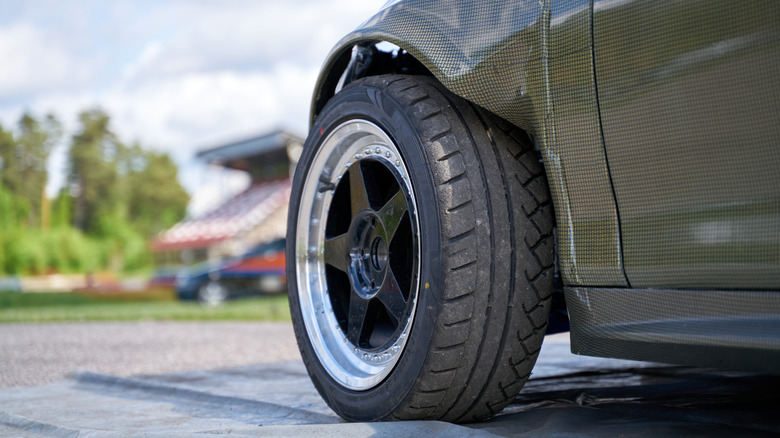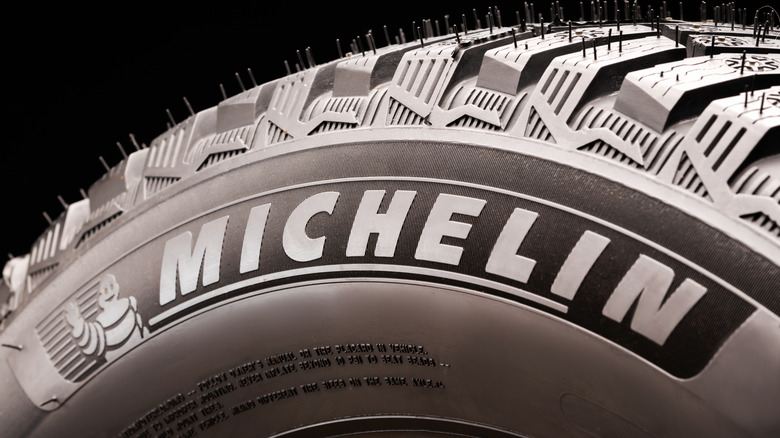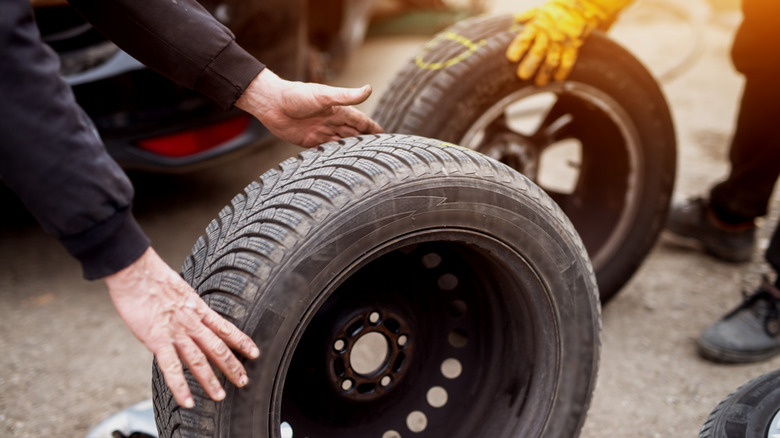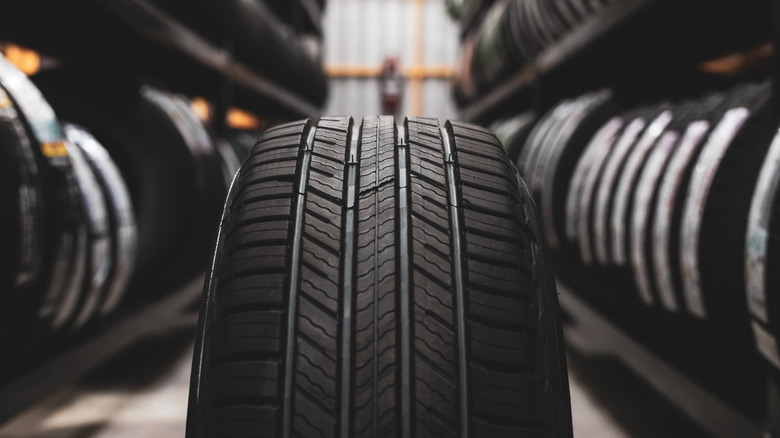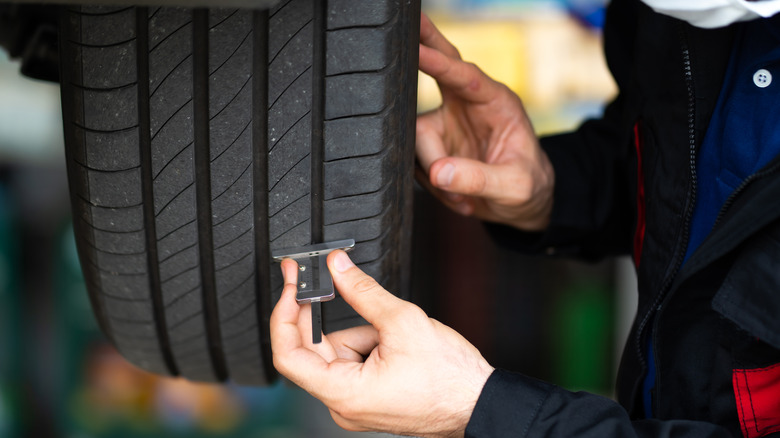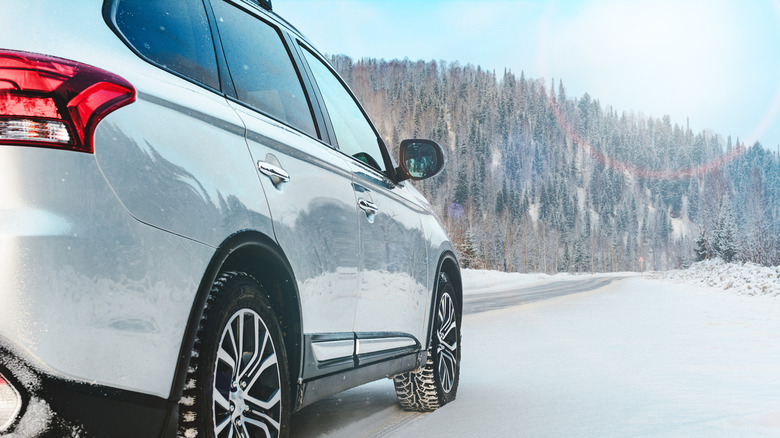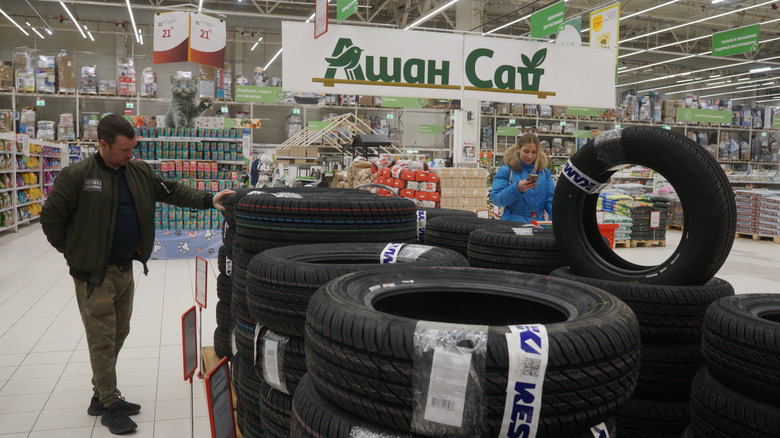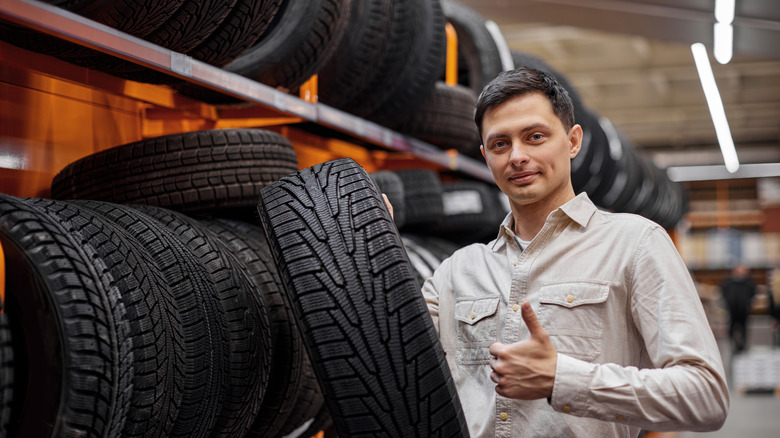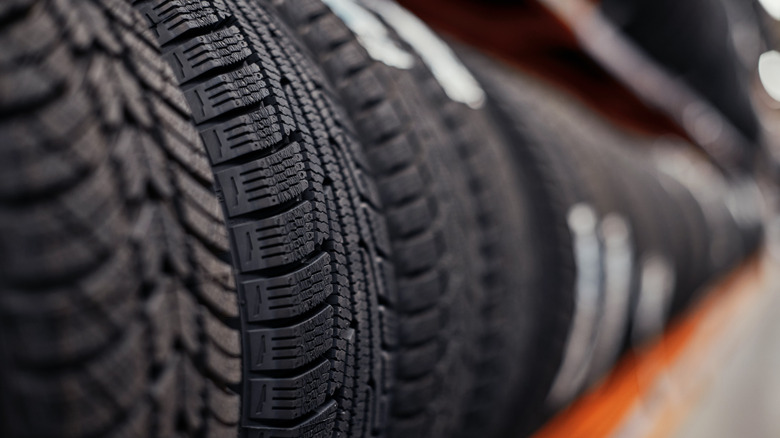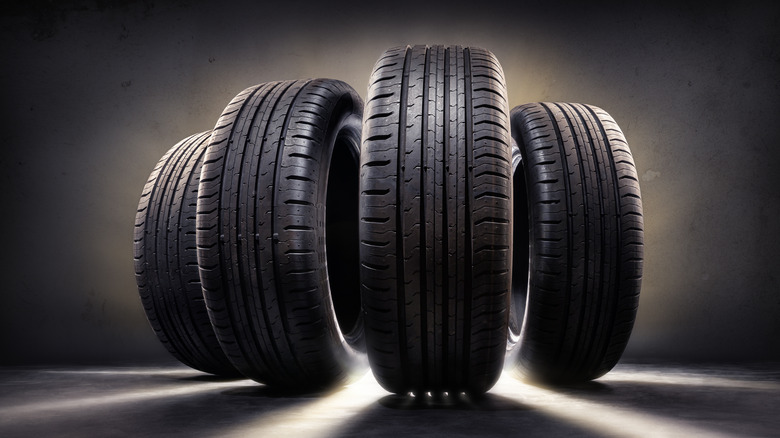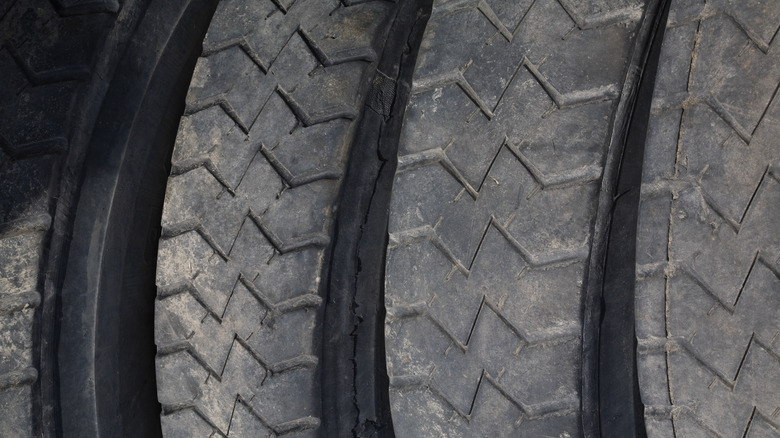10 Expert Tips For Buying New Car Tires
We may receive a commission on purchases made from links.
Tires are one of the most important components of every vehicle. For one thing, driving with car tires in good condition allows for a smooth road experience. Tires are the only direct connection between the vehicle and the road, and so they determine how well the car can respond to braking, acceleration, and cruise control. Using poor tires puts the driver and passengers at risk of fatal accidents, whether to them or to pedestrians. According to the National Highway Traffic Safety Administration (NHTSA), approximately 11,000 vehicle crashes are directly or indirectly caused by tire failures every year — and this number might be on the rise.
Thus, it's important to ensure that the tires on the car are always functional. And since they have a lifespan, car owners will definitely need to replace their set of tires at some point. There are a number of things to consider: from the car manufacturer's recommendations and tire ratings to the vehicle's daily use and driving terrain, the circumstances will differ for every car owner.
When it comes to road transport, car tires simply do not get the respect they deserve. It's easy to see why: they're made of rubber, operate with little to no exciting tech, and belong in the vehicle's exterior. But indeed, they can mean the difference between a successful journey and a fatal crash. The following tips should help you get the best tires for your car, avoid tire failures, and have fun while driving.
Be sure that you need a new tire
The first step to getting new car tires is to ascertain that you need them. This isn't always as simple as it sounds. On the one hand, ascertaining whether or not a tire needs replacement can be quite technical. A simple visual inspection might not reveal the tire's true condition, and car owners might need a more detailed study — or professional help — to determine the tire's current state. On the other, car tires can be quite costly. Depending on the tire size, vehicle type, and driver budget, tire buyers could find themselves spending between $400 and $1500 on a new set of tires (via MechanicBase)
That said, the average car owner can usually discover the condition of their tires by simply examining them. The most telling characteristics of a worn-out tire are loss of color (or fading), bulging and bubbles, cracks on the tire's sidewalls, and shallow or uneven treads. In addition, drivers can check for unfamiliar vibrations or noises emanating from the tires.
With respect to treads, the tire might have tread wear indicators, which are little protrusions in the tire's treads. If the indicators are at the same level as the treads, then the tire is worn out and needs replacement. Car owners with tires that lack an indicator can perform the classic coin test, which involves placing a U. S. penny into the tread with Abraham Lincoln's head going in first. If the top of Lincoln's head remains visible, then the treads have become shallow and unsafe for sustained use.
Know the type and size of tire you should get
With so many automobile models and tire manufacturers in the market, it's difficult to lump all tires into one category. But even more than this, it's inaccurate and dangerous. Picking the wrong type or size of tires could not only worsen the driving experience but also increase the risk of accidents. That's why it is important to decipher early on in the process what tire types and sizes are appropriate for your vehicle.
There are two major focus areas to achieve this. First, consider the size of the tire. Available tires for your vehicle will likely range from large tires that occupy much space in the wheel well, to medium-size tires, to smaller tires that are cheaper in cost and preferable to some drivers. Second, consider the tire manufacturer. Michelin, Goodyear, and Bridgestone are popular tire makers, and they design their tires to offer different levels of rolling resistance. The driving experience will not be the same, and neither will the tire costs.
Rather than doing this yourself, to ensure certainty in the process, a good alternative would be to consult an automotive professional. Before offering advice, a knowledgeable tire dealer would aim to find out your car's manufacturer, model, and year of production. This information will aid them in finding a range of tires that best suit your vehicle, from which you can decide based on your budget or other preferences. In every case, be sure to check that the tires are in top condition before purchasing them.
Check out other factors and ratings
While the tire type and size are essential considerations for purchasing new tires, they certainly are not the only factors. Every tire comes with specifications on its load capacity and tread wear, and tires function best according to a speed rating. All of this information should be obtained from your current tires before making a move to the tire market. The new tires should match these specifications.
In addition, it's important to check all four wheels of the vehicle for any problems that might hinder the tire from functioning optimally. One or more wheels may be damaged or have the rims deformed, implying that the tire would not be held tightly in place when affixed to the wheel. There could be cases of wheel misalignment, causing the vehicle's tires to have unequal contact with the road, and leading to uneven tread wear in tires. These incidents are quite common with all types of cars, and in some cases, they could be the major reason why tires do not last as long as they should.
Car owners willing to go the extra mile can top this up by checking the entire vehicle for any other problems that might affect tire performance. This could involve examining the suspension and transmission systems, to be sure that the tires can absorb shocks properly and that power is adequately distributed among the tires during driving. In this regard, it's best to consult a mechanic or automotive professional.
Pay attention to tire codes
A close look at the body of a tire reveals several inscriptions on its sidewall, all of which signify elements of the tire's specifications. There is at least one set of codes to look out for, called the "tire code". A concise alphanumeric combination, the tire code specifies seven major specs of the tire: tread width, tire type, aspect ratio, expected wheel diameter, internal construction, load rating, and speed rating. All of these can be read and interpreted using tire manuals and index guides, which are available on tire purchase or online.
For instance, the Toyota Corolla 2005 model has the stock tire code P 175/70R14 84 H. In this code, P signifies a passenger tire type; the tread width is 175 mm; the aspect ratio (i. E. height-width ratio) is 70; R points to a radial internal construction, and the expected diameter of the wheel is 14 inches. In addition, the tire is rated to carry a maximum load of 1102 pounds per tire — as is indicated by the load index 84 — and move at a maximum speed of 130 miles per hour, according to the speed rating index of H. These last two specifications are the most important, and exceeding any of them in vehicle use would risk tire failure.
In addition to the tire code, tires manufactured in the US would also feature a Department of Transportation (DOT) code and a UTQG code, which provide information about the tire make and factory test performance.
Think about use cases for your vehicle
When it comes to purchasing a new tire, even driving patterns and locations come into play. With respect to patterns, the tire choices might be different between drivers who use their vehicles daily and those who drive occasionally. Frequent use of vehicles naturally implies that tires would wear out sooner, as they spend more time in moving contact with the road. Thus, it's important for such drivers to go for tires built with durability and long life in mind. Drivers who utilize their vehicles occasionally can be less keen on this factor, although paying attention to it would significantly reduce the frequency of tire replacements and concerns.
With respect to locations, the nature and terrain of the roads should not be ignored. Those who reside in colder regions might find that they need to drive on snowy roads during the winter, and such roads are likely to be slippery. Getting tires with the right traction would prevent skidding and maintain good handling for the vehicle. This is a different experience from that of drivers in more temperate regions, where the roads are likely to heat up during the summer, and for which the tires would need to withstand such heat for long periods of time.
In both situations, it's worth noting that certain driving habits put the tires at risk of failure. Though exciting, routinely taking sharp turns, driving at top speeds, and coming to sudden stops place a great strain on tires and would quickly render them unusable.
Go through the manufacturer's tips
Before settling on a purchase, no survey process can be completed without consulting the car manufacturer's information on the car-tire relationship, through a paper manual or online. The automobile maker has the ultimate say on what kinds of tires are best for the vehicle, and such suggestions should be strongly considered. Where there is an inconsistency between your findings — or your tire dealer's recommendations — and the information in the car manual, it is advised to go with the latter, except there are reasons why this is not feasible. In any case, the final tire choice should be proven to perform the right way with the vehicle.
If the car manual is not available, check for an information placard on the vehicle. The tire placard should be located on the car's door jamb; in the US, car manufacturers are mandated by law to place this there. This placard would contain information about the tire features and car loading capacity, including the main tire code, spare tire code, and tire inflation pressure.
If you own an electric vehicle (EV), it is all the more important to verify the manufacturer's information. This is because tires carry the extra weight of the battery pack and drivetrain, which are heavier than the combustion engine in gas-based vehicles. The torque patterns are different, as EVs feature a more instantaneous torque than non-electric cars. Several other factors — including traction, noiselessness, and rolling resistance — should also be factored in, while prioritizing manufacturer details in making a choice.
Browse various markets
When thinking about getting the best tires, it's only right that you get the best deals as well. There are generally two options: you either purchase from a physical tire dealership, or you order from an online store. A physical purchase means that you get to see the tires before buying and can tell that they're of high quality. Many car owners prefer this method, as it allows for a strong sense of confidence in the tire before it's bought. On the other hand, online stores can offer really attractive perks for buyers. They might sell the same tires at significantly cheaper costs or set discounts when a buyer gets a set of four tires. Plus, by ordering tires from home, car owners do not go through any inconvenience associated with going to a store. Bear in mind, installation of the tires may cost extra (via TireRack).
Even among physical and online tire stores, there are many options available. Online stores include TireRack, TireBuyer, and Amazon, each selling at its own price and with its perks. Many buyers who prefer physical stores may be loyal to a local dealership, where they can negotiate with the store managers to get good deals. Others might stick with one tire brand, purchasing and servicing all their tires at Goodyear or Bridgestone. Exploring all of these options might be daunting, but in doing so car owners could save good money, get better tires, or save on installation costs.
Read buyer reviews
There's no better test of confidence in a new tire than the reviews of others who have previously purchased or used it. Customer reviews give an inside look into the functionality of the tire and its driving experience. In cases where you cannot take the tires for a spin in your vehicle, such reviews could be your most important aid in making the best choice.
While all kinds of reviews might be worth considering, those by honest tire experts would matter all the more. Some of such experts are creators on online sites, where they delve into the pros and cons of different tires and shed more light on their use. Others are simply people who have used cars for a long time, have a ton of experience with tires, and elect to leave their thoughts and comments on online discussion platforms like MyCarForum.
When searching for reviews online, be sure to look for negative comments as well, as they tell a story that tire manufacturers and dealers would not. Search for and study any complaints by people who have used such tires or look for any problems for which a solution could not be offered. Using all that information, you can eliminate several choices from a range of tires that meet your needs and find the exact tire make that balances price with quality.
Consider replacing all four tires
When it comes to road transport, safety and functionality are paramount. And with respect to car tires, replacing the entire set together will give you the best of both worlds. Having only one or two tires changed might negatively impact the vehicle's handling and make it more difficult to navigate, thus increasing the risk of an accident. While it isn't always a problem to change only one tire, it could create an inconvenience that can and should be avoided.
Of course, the cost of replacing all tires is much higher than that of replacing one tire. Given the already high price range for car tires, many buyers will be hesitant to make this decision. However, the investment will be totally worth it. Car owners can explore opportunities to reduce these costs, such as looking for tire dealerships with discounts on a set of tires, online stores with free shipping, or any bonus opportunities offered by tire manufacturers.
It's worth noting that if one tire is significantly more worn down than the others, there may be a problem with the vehicle itself. The wheel to which that tire is attached might be misaligned, or there could be a problem with the suspension system in that location. Thus, attempting to change all four tires could reveal other problems with the vehicle, which can then be addressed before the replacement is complete.
Consider an upgrade
While some car owners might prefer a direct replacement to their previous tires, others would rather go for an upgrade. High-performance tires improve the car's driving experience, making them a top choice for car enthusiasts. But getting such an upgrade right can be complicated. Considering that upgraded tires are a deviation from the car manufacturer's specifications, tire buyers will need to work with automobile professionals on such an upgrade.
The choices for car tire upgrades range from new tires with a larger size to tires with different design features. Getting larger tires might necessitate changing the car's wheels to accommodate tires of a different diameter. And due to the fact that more power needs to be transmitted to the tires, the vehicle's fuel economy is reduced. A poor selection of larger tires might also impact the vehicle's handling, and control, making the car unfit for certain types of driving terrain. There's also the danger of the tire making contact with the vehicle's wheel well, especially while crossing speed bumps. With respect to new tire tech, run-flat tires are becoming increasingly popular in luxury vehicles, as they prevent the tire from going flat when punctured. The implications of using any of these tire types should be duly considered, alongside the cost demands, before a decision is made on the tires.
Should you buy a new or a used tire?
For car owners on a budget, buying a brand-new set of tires might be infeasible. A used tire that's still in good condition might serve their purposes while being cheaper. There are implications to this, of course. Used tires have already been used, so they will have a reduced life span. In addition, they may come with tread wear and sidewall cracks, no matter how little. Thus, buying used tires should be done with the understanding that they cannot serve as long — and as well — as new tires, nor will the driving experience be the same.
Even in buying used tires, car owners must look out for tire specifications and ratings. The load-carrying capacity and speed rating should correspond with the manufacturer's recommendations, and the tire dimensions should be suitable for the vehicle's wheels. In addition, used tires should be tested in similar driving conditions and terrain as you'll encounter before making your final purchase. Buying a used tire for slippery roads might not offer much of an improvement, for instance, and using a tire with weakened rubber may be dangerous in the summer. In general, it is always better to pool resources toward getting a new set of tires that will function optimally, allowing for a remarkable driving experience, maintaining the vehicle in top shape, and keeping drivers and passengers safe.
